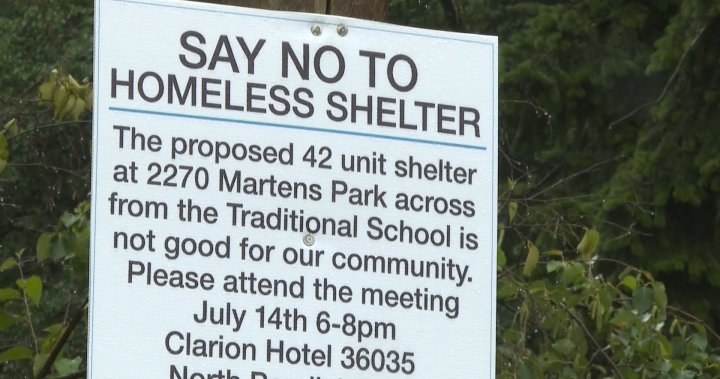The announcement of a 50-unit supportive housing project in Abbotsford’s downtown core has sparked intense community debate, highlighting the growing tensions between addressing homelessness and residents’ concerns about neighborhood impacts.
At last week’s community consultation meeting, the gymnasium at Godson Elementary School overflowed with concerned citizens. I watched as Mary Reimer, a 68-year-old who has lived two blocks from the proposed site for over three decades, approached the microphone with trembling hands.
“We support helping the homeless, but we’ve already shouldered more than our fair share,” she told BC Housing representatives. “My grandchildren walk by that corner to school every day.”
The project, announced in February by the provincial government through BC Housing, aims to convert the former Valley Inn at 2073 Emerson Street into permanent supportive housing for individuals experiencing homelessness. The $14.6 million initiative would include on-site support services and 24-hour staffing.
According to BC Housing data, Abbotsford’s homeless population increased by 21% between 2020 and 2023. The 2023 point-in-time count identified 223 people living unsheltered in the city, though outreach workers suggest the actual number may be significantly higher.
Mayor Ross Siemens has publicly supported the project while acknowledging community concerns. “We recognize the need for this type of housing, but we also understand that residents have legitimate questions about how this will impact their daily lives,” he said in a statement released by the city last month.
The “Save Our Downtown” coalition, which claims to represent over 400 area residents and business owners, has collected nearly 2,000 signatures on a petition opposing the location. Their concerns center on potential increases in public drug use, property crime, and the proximity to three schools within a six-block radius.
Local business owner Trevor Mitchell, whose automotive repair shop sits across from the proposed site, expressed frustration with the consultation process. “They presented this as a done deal. The decision was made before they ever asked us what we thought,” Mitchell told me as he showed security footage of three break-in attempts at his shop over the past year.
BC Housing spokesperson Dominica Patterson defended the project’s location and engagement process. “We’ve held three public information sessions and two focused stakeholder meetings. The feedback has helped shape security protocols and community integration plans,” Patterson said.
What makes Abbotsford’s situation particularly complex is the city’s history with homelessness issues. In 2013, city workers spread chicken manure on a homeless encampment, drawing national criticism and a formal apology from then-Mayor Bruce Banman.
The Fraser Valley community has since developed more nuanced approaches, but tensions remain. The Salvation Army operates the 30-bed Riverside Shelter downtown, while the 40-unit Hearthstone Place opened in 2020, providing supportive housing with mixed community reception.
Dr. Julian Somers, a housing researcher at Simon Fraser University, notes that community resistance often stems from implementation concerns rather than opposition to helping vulnerable populations. “Research shows dispersed supportive housing with appropriate resources tends to integrate better than concentrated facilities,” Somers explained. “Communities need meaningful input into how these projects operate.”
The Emerson Street project’s opponents point to issues at similar facilities in Chilliwack and Maple Ridge, where residents reported increased emergency calls and public disorder following openings.
However, Fraser Health addiction specialist Dr. Amanda Wong cautions against assuming similar outcomes. “Each community and facility is unique. When properly resourced and managed, these projects can actually improve neighborhood stability by getting people off the streets and into care,” Wong said.
Council member Patricia Ross, who has served on Abbotsford City Council for over two decades, finds herself in a difficult position. “I’ve heard from constituents who are deeply concerned, but I’ve also spoken with families whose loved ones desperately need this housing. There are no simple answers here.”
At the heart of this debate lies a fundamental question about community responsibility. Local pastor Mark Stevens of Hillside Community Church believes both sides have valid points. “Our congregation includes both homeless individuals and homeowners worried about property values. What’s missing is a way forward that honors everyone’s dignity.”
Next week, city council will vote on the required zoning variance, though BC Housing could potentially proceed without municipal approval under provincial authority.
As Abbotsford grapples with this divisive issue, similar scenarios are playing out across British Columbia. Provincial data shows 44 supportive housing projects have been announced since 2021, with more than half facing some form of community opposition.
For residents like Reimer and business owners like Mitchell, the coming weeks will determine whether their concerns alter the project’s trajectory. Meanwhile, those currently living in tents along Gladys Avenue and under the Marshall Road overpass await word on whether potential housing will materialize.
The outcome in Abbotsford may well become a template for how other communities navigate the delicate balance between addressing homelessness and responding to neighborhood concerns – a balance that remains elusive in communities across the country.






